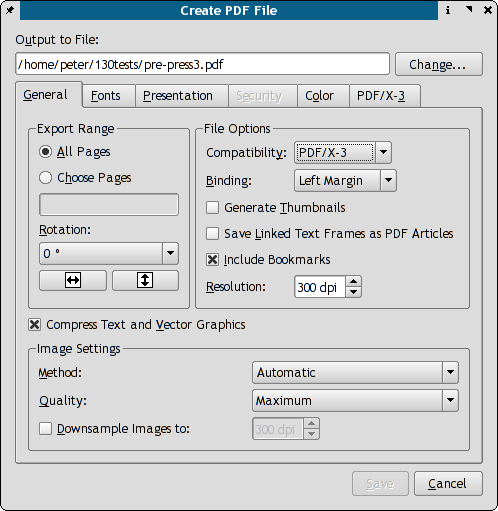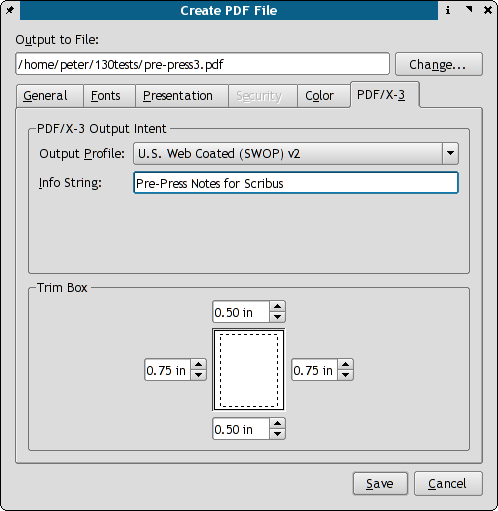
Support for PDF/X-3 is a major milestone in the development of Scribus. Scribus was the first DTP application to support a demanding, but open ISO standard: ISO 15930-3:2002. This type of support for high quality PDF creation has been, until now, available only in expensive proprietary applications. Moreover, creating "press ready" Creating commercial press ready PDFs has historically been fraught with errors, especially for users unfamiliar with the nuances of postscript, PDF distilling and varying capabilities of image-setters. The saying "It is hard to create a good PDF, but really easy to mess up", has a great deal of truth. The more common usage of the Adobe Acrobat Distiller family of applications for PDF creation has typically needed knowledge of at least some of the close to 100 Distiller parameters.
In European countries the concept of PDF/X has been more widely accepted than in North America. Much of the push for these standards has come primarily from Germany and German pre-press companies, a worldwide leader in press and high end digital imaging technology.
The creation of PDF/X, currently with 3 defined ISO standards, is in part, an attempt to provide end users and creators with a vendor neutral measuring stick to vet files as suitable for professional printing or exchange with service bureaus. Scribus now has easy to understand and use options which enable end users to create 100% PDF/X-3 compliant files. By judicious use of PDF options, end users can be assured their files, if they require, too be 100% standards compliant. As always, be certain any PDFs you create can be used in the work-flow of your printer or pre-press service bureau. Not all are equipped to handle the latest in PDF technology. The latest Prinergy and Harlequin image-setting work-flows are capable of supporting PDF/X-3
Warning: all images should be in RGB, not CMYK before importing. Otherwise, unwanted color shifts may appear.
This panel will open first and select PDF/X-3 in the compatibility drop down as shown below. This will change the default settings, as needed, automatically.
 |
Next, select the Color tab, as shown below:
 |
Here is where you select color profile choices to embed in the PDF. By not selecting or embedding an ICC profile for solid colors, CMYK is automatically assigned as the color space.
Next,select the PDF/X-3 tab, as shown below:
 |
This is where you can adjust the trim box, as well as embed in the PDF the intended press condition, which is defined by the ICC printing profile. This is probably the most important choice in terms of color profiles, as it affects color throughout the whole document. You can also put in a short note about the document, which is useful later on. This should not be left blank - otherwise - technically it will fail the PDF/X-3 standards.
Note: Because of the exacting standards of PDF/X-3, some PDF features are disabled including encryption, presentation effects and all fonts are automatically embedded. Likewise, annotations and transparency is disabled. You should carefully follow the advice given in PDF Export Options for file preparation and choice of image formats.
When you require very precise color reproduction and your printer can accept PDF/X-3 files. Without support from your printer, you are likely to have adverse color changes compared to more traditional PDF export.
Yes, the design of PDF/X-3 is intended to provide a fully color managed PDF work-flow, without detailed knowledge of actual printing technologies.
In brief, PDF/X-1a requires the following: The color space to be CMYK/greyscale, all the fonts are embedded and the PDF indicates whether it is either pre-trapped = true or not-trapped = false. Think of this as a blind hand-off, as there is no certainty of how it will output.
PDF/X-2 is a looser standard - but with the requirement for more knowledge between the supplier and receiver of the file. Fonts are not required to embedded and it is possible to use OPI (Open Press Initiative). PDF/X-2 also allows device in dependent color spaces, like CieLab, to be used.
PDF/X-3 allows for ICC color profiles to be resident in the PDF, as well as different output intents and 'DeviceN' (spot color) color space - now supported in the AFPL version of Ghostscript 8.0+. This also allows overprinting colors.
http://www.ddap.org/resource_center/article_index.php
http://www.ipa.org/PDFS/pdfxguide.zip
http://www.pdf-x.com/downloads/pdf/application_notes_pdfx3.pdf